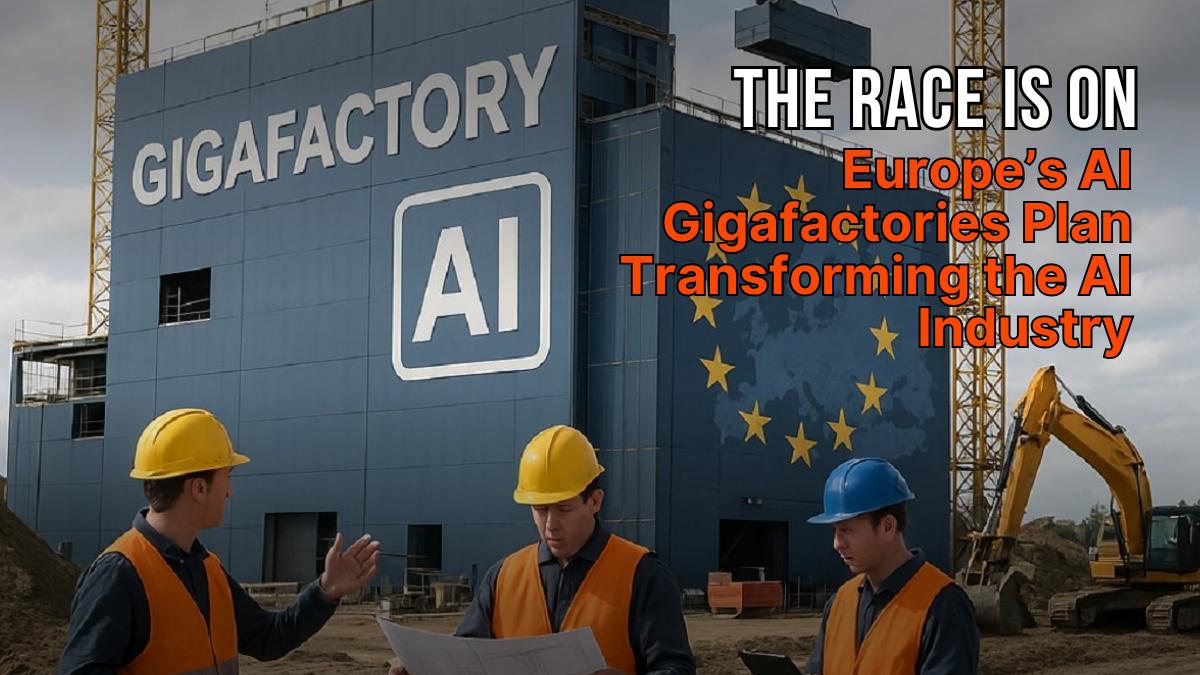Europe is poised to revolutionize the global AI landscape with an ambitious plan to develop AI Gigafactories. With 76 companies expressing interest in this initiative, the European Union aims to create cutting-edge infrastructure to host advanced AI systems, empowering businesses to innovate and close the technological gap with global leaders like the US and China. This blog explores the plan’s details, its importance for innovation, and what it means for Europe’s dominance in AI.

What Are AI Gigafactories?
AI Gigafactories are massive facilities designed to develop and train advanced AI models. Envision them as manufacturing plants, but instead of physical products, they churn out AI innovations. These Gigafactories symbolize technological advancement on a massive scale, housing tens of thousands of AI processors to meet the growing demands of artificial intelligence.
The European Union’s vision involves creating AI-specific infrastructure that builds on existing technology, such as the EuroHPC supercomputing network. But instead of simply expanding computing power, these AI Gigafactories will integrate hardware, software, data, and talent into cohesive hubs for AI development.
Why Europe’s AI Gigafactories Are a Big Deal
Europe’s push for AI Gigafactories represents much more than an economic strategy. It’s an effort to establish technological sovereignty and reduce reliance on foreign tech giants. Here’s why these Gigafactories could be game-changing:
- Closing the Capability Gap: Europe has often been criticized for lagging behind the US and China in AI development. This initiative could position Europe as a global leader by creating the infrastructure required to train state-of-the-art AI models.
- Fostering Innovation: For startups and smaller companies, accessing high-power AI capabilities has been costly and unattainable. These Gigafactories democratize access, allowing enterprises of all sizes to scale their AI solutions.
- Sustainability Efforts: Training AI models requires immense energy. By integrating renewable energy sources and innovative cooling solutions, Europe’s Gigafactories could set a benchmark for sustainable tech development.
The Scale of the Initiative
The magnitude of Europe’s AI Gigafactories plan is unprecedented. Through public-private partnerships, the EU aims to invest €20 billion to establish these facilities, and plans to mobilize a total of €200 billion for AI innovation through its InvestAI framework. Notable achievements so far include:
- 76 Proposals Submitted: Top tech companies, telecom providers, and industry players have expressed interest, covering 60 sites across 16 EU nations.
- Three Million GPUs: Companies plan to acquire advanced AI processors to handle some of the most complex AI modeling globally.
- Four to Five Gigafactories Planned: These facilities will each house 100,000 processors, marking a monumental leap in computational power for Europe.
Applications Across Sectors
The development of AI Gigafactories will impact industries across the board. Here’s how different sectors stand to benefit:
- Healthcare: Enhanced diagnostics and AI-driven research could make healthcare more efficient and accessible.
- Climate Science: AI can help analyze vast datasets to combat climate change, develop sustainable solutions, and create predictive models to mitigate environmental risks.
- Business and Finance: AI-powered analytics and decision-making tools could streamline operations and boost innovation.
- Entertainment and Retail: From personalized customer experiences to advanced content creation, the retail and entertainment sectors stand to undergo a significant transformation.
Addressing Energy Challenges
A key concern with AI Gigafactories is their substantial energy consumption. Training advanced AI models requires enormous electricity, raising questions about sustainability. Fortunately, many proposals include innovative solutions:
- Renewable Energy Integration: Projects like one in Northern Sweden plan to use hydroelectric power combined with natural cooling solutions, setting a precedent for sustainable AI facilities.
- Energy Efficient Designs: Companies involved in the project are expected to pioneer new methods for reducing energy footprints, ensuring that economic growth aligns with environmental responsibility.
What Lies Ahead
Though the excitement around Europe’s AI Gigafactories is palpable, actual implementation will require careful coordination. The European Commission plans to issue formal calls for Gigafactory establishments by the end of 2025, and the initiative will be overseen by the EuroHPC Joint Undertaking. However, steering such projects across multiple countries, regulatory environments, and private stakeholders will likely take time.
For everyday citizens, the impact may not seem immediate, but the ripple effects will be profound. From advancements in technology and healthcare solutions to economic growth and strengthened AI startups, the real beneficiaries of this initiative are European businesses and consumers.
Europe’s Strategy in the Global AI Race
With this bold initiative, Europe aspires to not just catch up but potentially lead the global AI race. By focusing on sovereignty, democratizing AI access, and promoting environmentally conscious practices, these Gigafactories could define Europe’s approach to AI innovation. Unlike the profit-driven ambitions of other global leaders, Europe’s strategy focuses on ethical AI development aligned with its values.
FAQs About AI Gigafactories
Q. What are AI Gigafactories?
A. AI Gigafactories are large-scale facilities designed to advance artificial intelligence innovation and production. They focus on developing cutting-edge AI technologies while adhering to ethical and sustainable practices.
Q. Why is Europe investing in AI Gigafactories?
A. Europe aims to establish itself as a global leader in ethical AI development. By investing in AI Gigafactories, the region seeks to foster innovation, maintain technological sovereignty, and promote sustainable practices in the AI landscape.
Q. How do AI Gigafactories differ from traditional AI research facilities?
A. AI Gigafactories operate on a much larger scale and with a broader scope compared to traditional research facilities. They integrate research, development, and production in a way that prioritizes ethics, sustainability, and pan-European collaboration.
Q. What is the significance of ethical AI development?
A. Ethical AI development ensures that AI technologies are aligned with fundamental human values, including privacy, fairness, and transparency. This approach mitigates risks while fostering trust among users and stakeholders.
Q. How will AI Gigafactories impact global AI innovation?
A. Europe’s AI Gigafactories aim to set new benchmarks for ethical and sustainable AI development. Their influence could inspire other regions to adopt similar models, transforming the global AI landscape.
Click HERE For More
